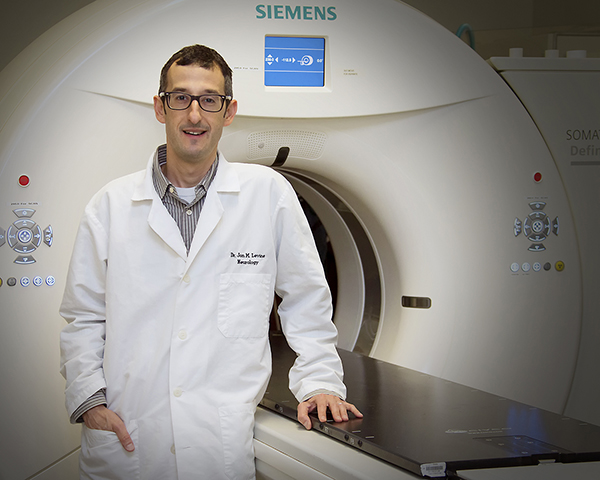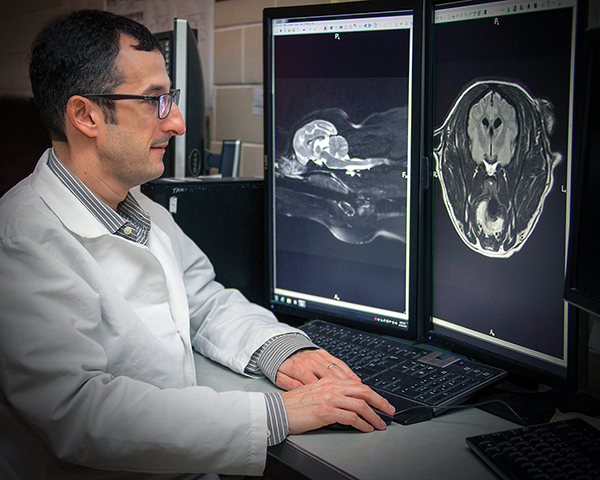Vital Observations
Dr. Jonathan Levine, head of the Small Animal Clinical Sciences Department, shares his perspective on how the Small Animal Hospital has changed, what makes it great, and his vision for the future.
Story by Jennifer Gauntt

The Texas A&M Veterinary Medical Teaching Hospital (VMTH) is all about the animals, but as head of the Texas A&M College of Veterinary Medicine & Biomedical Sciences’ (CVM) Small Animal Clinical Sciences (VSCS) Department, Dr. Jonathan Levine is all about the people.
Levine, a professor of neurology and the Helen McWhorter Chair of VSCS, works to ensure that the Small Animal Hospital (SAH) maintains its three core functions—leading-edge patient and client care, innovative teaching, and clinical research—by taking care of both the people who provide those services and the clients who entrust the SAH with the care of their beloved pets.
“I’m proud of our people. Everybody—from the technical staff to our faculty, to our interns and residents—does amazing, amazing work, and to be part of all they do is a real gift,” Levine said. “Our job is to support people; we want to help them to be the best and that feeds into our clients, our research, and, really, everything we do.”
As the VSCS leader for the past four years, Levine has emphasized the importance of listening, accepting both positive and negative feedback, and offering compassion. He’s also sought the guidance of psychologists and social workers to create a climate that values mindfulness and the general wellbeing of his employees.
At the same time, the SAH has experienced massive growth in energetic clinicians and specialty areas that have allowed the hospital to expand their advanced services.
“Look at oncology,” Levine said. “In 2015, we had one radiation oncologist, two board-certified oncologists, and a couple of residents. Today that group has grown into a comprehensive oncology service that provides each client with integrated expertise from surgeons, medical oncologists, and radiation oncologists. The number of cases coming in has exploded in that area, and a lot of them are referred to us by other specialists.”
Through his “listening” approach, the hospital also has begun to identify areas within its 16 specialty services—which range from emergency medicine to dentistry, to ophthalmology, diagnostic imaging, and sports medicine & rehabilitation—where workflow can be improved.
“Everyone who works in the SAH knows we can improve how we see patients and deliver care,” he said. “Although focusing on processes is not the most exciting work, we believe that when we get workflow right, it makes people’s lives better, whether it’s our clients, our patients, or the people who are doing the day-to-day clinical work, and we want to do that.”
Intricately linked to the missions of patient care, teaching, and research are the top-tier clinicians who are dedicated to the values of innovation and discovery.

This has been facilitated by supporting investigators such as Kate Creevy, an associate professor of small animal internal medicine, who recently received a $22-million National Institutes of Aging grant for her Dog Aging Project, a long-term study designed to understand how genes, lifestyle, and environment influence aging.
The discoveries clinician-scientists like Creevy will make will not only impact veterinary medicine, but human medicine, as well. External collaborations between SAH clinicians and those at Baylor College of Medicine and MD Anderson further emphasize that point.
“There’s a tremendous opportunity for teaching hospitals to be innovation engines and places where new, meaningful discoveries blend with excellent patient/client care,” Levine said. “What does that look like? It looks like clinical trials that are done with human health care partners, wherein everything from cancer drugs to cardioprotective drugs, to new ways to battle arthritis are approached in animals, with the hope for future changes to human health care.
“It also can look like new cardiac devices that have already been used in human medicine making their way into veterinary medicine,” he said. “Our teams have been among the pioneers for generating everything from implants to procedures that are changing lives.”
His dedication to thinking about the SAH as an “innovation hub” has been a game changer for the hospital, while also representing the future of veterinary medicine.
“The telehealth program that we’re embarking on is like being on a ship, and there’s this distant land far away. We know how valuable it is in human medicine and we’ve seen parts of it in veterinary medicine with teleradiology, for example,” Levine said.
“Now there’s this opportunity through change in the profession to look at how we deliver the VMTH into someone’s house. That’s incredible, to have internationally recognized experts, primary care clinicians, and ER docs talking with either an established client or a new client,” he said. “How do you get a practitioner who’s living in rural Oklahoma, or Houston, or West Texas access to a dermatologist? If that clinician can virtually be in an exam room, receive digital images at Texas A&M, and talk with clients live, it’s a game changer.”
While what’s on the horizon for veterinary medicine is exciting, making those things accessible will have the biggest impact on both the patient and the client, in whom hospital clinicians, students, and staff regularly witness the profundity of the human-animal bond.
“Everything we do ultimately impacts individuals. We’re able to deliver excellent care because the environment in the hospital is right, because the values are aligned, because we’ve helped innovate care. We’ve built it,” Levine said.
“When all our arrows are pointing in the right direction, the outcomes are great for clients. Our clients are treated kindly and respectfully and are listened to, because that’s modeled throughout our organization.”
###
Note: This story originally appeared in the Fall 2019 edition of CVM Today.
For more information about the Texas A&M College of Veterinary Medicine & Biomedical Sciences, please visit our website at vetmed.tamu.edu or join us on Facebook, Instagram, and Twitter.
Contact Information: Jennifer Gauntt, Director of Communications, Texas A&M College of Veterinary Medicine & Biomedical Sciences; jgauntt@cvm.tamu.edu; 979-862-4216


